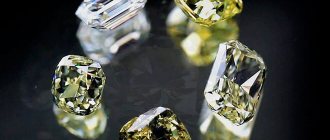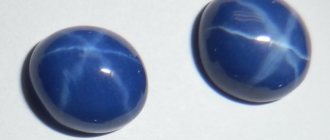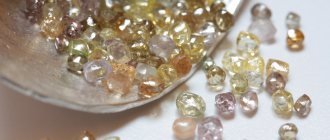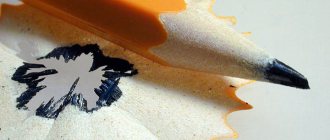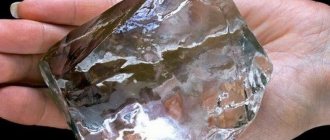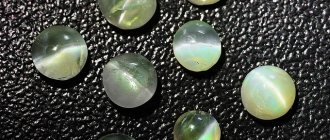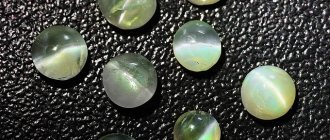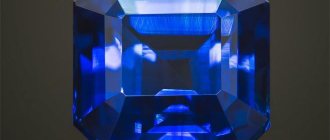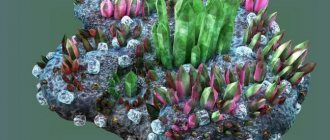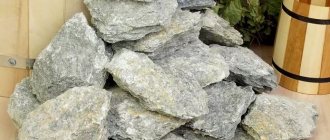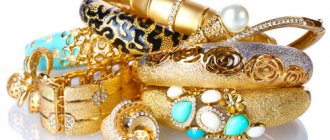- Home page
Due to their unique properties, natural and synthetic diamonds are used to create jewelry, in the production of high-precision and medical equipment, and highly durable instruments. Stones are divided into jewelry and technical. The former have a high degree of transparency, can have unique fantasy shades and, after cutting, refract light with a characteristic shine. Technical samples do not have such high characteristics; they are not cut, but are used for the needs of science and production. Despite all the advances in the synthesis of artificial stones, diamonds remain a valuable material and a desirable acquisition.
Useful properties of the gem
Diamond is the hardest substance in the world. It is a modification of the chemical element called carbon. At high temperatures, diamond changes to graphite, but if there is no access to oxygen. In a normal environment, stone begins to melt at a temperature of 800°C. Without the supply of oxygen, this process occurs at 2000°C.
List of characteristics:
- density – from 3.4 to 3.5 g/cm³;
- thermal conductivity – 2300 W (mK);
- friction coefficient – within 0.1;
- minimum compression rate;
- high modulus of elasticity.
It should also be noted that the latter figure can increase 5 times. This happens if there is no film of adsorbed gas on the surface of the gem.
When oxygen enters and air temperature is high, diamond turns into carbon dioxide.
Artificial methods
Diamonds can also be found on the surface. If you're lucky, you can find them in fortresses and mines, but if you need endless sources, then this is not it. The al generator will provide you with endless resources. Or, if you like, call it a factory, or a farm. A plant is an industrial, artificial method of extracting these minerals. How to make such a generator? There are different techniques, but we suggest making a generator, perhaps the simplest (and fastest). Details can be found in the video, but for those who like to read, a short guide on how to make a diamond generator in Minecraft:
- First, we need to make an artificial portal to Minecraft hell.
- Make parapets 9 blocks long from both portal columns. For example, made of wool. Again, details in the video about the generator.
- Pour 2 blocks of water into this pool.
- Such a plant requires the installation of two workbenches on the parapets.
- To clone endless al., you need to jump into the water. How exactly, watch the video about the generator.
We told (and showed a video) how to make a diamond generator in Minecraft. Infinite supplies are possible, as the wiki says, if you use cheats and codes (commands). An artificial diamond can be obtained by writing a certain code. You can find out exactly what code it is in the reference book. By the way, the codes are completely different. But this method, like diamond, is too artificial. Another artificial (non-industrial) method is cheating. But he, moreover, does not provide endless al. in Minecraft.
For being with us, you will receive a bonus - a super diamond armor skin for Minecraft. You can find it here.
Use of diamond in jewelry
Not all types of diamonds are used to make precious items. The stone should have as few microcracks as possible and not be cloudy. Also pay attention to the presence of shades. A high-quality material is one that does not have a gray color.
To give the stone incredible shine, it is initially treated. The surface is polished using the same diamond. This is the only way to get the desired result. This material processing technique was discovered in India by a jeweler. Since then it has been used all over the world.
As for sawing, this was previously done using steel wire. The result was good, but it took a long time to separate the stone into pieces. Therefore, over time, sawing began to be carried out using a bronze cutter. It contains emulsion and diamond dust.
Preparation
If long hikes are not for you, then you should prepare for quite a long excavation of the earth’s bowels. Where to get diamonds in Minecraft? Rocks can be located at very different depths. In particular, it was noted that deposits of this mineral are found in large quantities at a depth of 12 blocks. Moreover, they can be found even more often near lava. But more on that later.
Before you go digging for diamond ore, you will need to make some items to take with you, namely:
- Lots of torches. From 100 pieces. Made from sticks and silicon.
Use in production
Not everyone uses diamonds in production. High-quality material has a high price, so it is irrational to use it on a large scale. Artificial diamonds are most often used in production.
Despite its advantages, diamond is a rather fragile stone.
They are obtained in several ways:
- From steam. For this, the chemical deposition method is used.
- Using high pressure and maximum temperatures.
- A substance containing a large amount of carbon is undermined.
Those stones that have not been cut are classified as industrial diamonds. They are also used to make tools.
Diamonds are made from:
- drill;
- grinding tools;
- scissors;
- cutters;
- glass cutters.
Thanks to such details, high-quality metal turning occurs. Drills for drilling oil wells are also coated with crumbs.
Construction works
One of the main advantages of diamond is its hardness. This is the strongest mineral in the world and in most cases it is this indicator that determines the wide scope of its use in construction.
Interesting! Modern construction work is carried out with the participation of volumetric structures made of concrete. Dismantling, drilling, sawing and cutting such durable materials requires not only powerful equipment, but its coated parts, whose crystal lattice is stronger and stronger.
Drills, saws and knives with a special diamond powder coating cope with granite, marble and concrete, easily grind stones and crushed stone, punch and drill holes of any diameter.
Be sure to check out: Sapphire and ruby corundum: main differences from natural stones
THE AMAZING MAGIC OF DIAMOND A diamond is a natural substance, a precious stone, and a technical raw material.
He was famous in… Posted by Lemon Saturday, November 1, 2014
Laying cables and trenches cannot be carried out without the use of special equipment - a roadheader. Its main element is a disk with a blade coated with technical diamond chips.
Use of gems in industry
Diamonds are widely used due to their incredible strength. Parts that are coated with crumbs have a long service life. The advantages also include low noise during operation, high speed of task completion and incredible cutting accuracy. The stone does not leave cracks, chips or other deformations on the surface.
For the manufacture of tools and components for them
Nowadays, diamond tools are used for drilling concrete. When processing such a surface, no dust appears and there is no vibration.
Often drills with diamond chips are used for:
- creating water supply holes;
- installation of air conditioners;
- taking samples from rocks.
This precious material has also found application in the space sector. Diamond is used to coat various devices so that they become highly durable and last as long as possible.
Telecommunications
This type of crystal helps to conduct several communication lines of different frequencies through one cable. It is not susceptible to sudden temperature changes and does not respond to power surges. The stone is also used in photocells and parts for optical instruments.
In order to get the desired result, it is enough to use a particle of stone that will be invisible even to the human eye.
Medicine
In this area, diamond is an indispensable item. Surgical scalpels are processed with a similar stone. Thanks to it, sharp blades make thin cuts, which is important in medicine.
The latest development of scientists is a medical laser. Its main component is diamond, which acts as a conductor.
Nuclear industry
In this area, diamond is used to create nuclear radiation. When a particle is charged, a flash is formed in the stone, from which a current pulse appears. No other gem evokes such a reaction.
Chemical and physical sphere
Since diamond, compared to other stones and materials, is not susceptible to the effects of various acids, it is used as a protective element. All parts that are created on the basis of diamond are error-free and work properly for many years.
Medical field of use
Thanks to the qualities described above, diamond has become an indispensable material in the medical field. Although this is a relatively new area of its application (unlike industry), it is already clear that it is the future.
So far, the main area of application of diamond powder in medicine is the creation of high-quality instruments. A specially coated scalpel is used in surgery to make cuts more precise. It is indispensable for complex operations. For example, on the spinal cord or brain.
In addition to scalpels, diamond is used to create scissors and clamps. The material is used in the manufacture of dental equipment. A medical laser project is under development, where the mineral will act as a conductor.
Interestingly, since 1953, about 97% of industrial diamonds have been replaced by artificial crystals. You can learn more about them by reading the article “About artificial diamonds and polished diamonds.”
What does a diamond look like?
Answering the question of what a diamond looks like in nature , we can safely admit that it is rather unattractive. The stone has a rough surface, faded color and is often covered with a grayish crust with cracks. A diamond is made from a diamond only by careful and high-quality cutting of the stone, which includes many stages.
Scientifically speaking, diamond is considered a mineral in the form of allotropic cubic carbon.
Under normal conditions, this stone can exist for an unlimited amount of time. But when placed in a vacuum at high temperatures, it turns into graphite. The same effect can be achieved by placing the mineral in an inert gas.
Diamond has the following features:
- Dispersion.
- Ability to conduct heat.
- Highest level of hardness.
- High degree of refraction.
- Low air-to-metal friction.
- Highest abrasion resistance.
- The highest elasticity in comparison with other minerals.
- Lowest compression ratio.
- Luminescence. As a result of exposure to ultraviolet, x-rays and cathode rays, the diamond glows in different colors and casts glare.
- In addition, diamond has unique dielectric properties.
How to recognize fake diamonds?
Sometimes it can be extremely difficult to distinguish a real diamond from a fake, and only a true expert can do this.
However, there are a number of ways to help identify a fake:
- Trick with newspaper text. This method is only suitable for checking those stones that are not fixed to any frame, or are fixed in such a way that the smooth side of the stone can be applied to the surface of the newspaper. If the text is indistinguishable and merges into something incomprehensible, then most likely the diamond is genuine. If you can easily see the letters, then it is a fake. A real diamond refracts light many times, making it impossible to read text through the stone.
- Water test. A real diamond becomes invisible and seems to disappear when placed in a glass of clear water.
- The back side will tell you a lot. As a rule, a true diamond, when set, remains visible from the back, i.e. you can see its tip located on the back side of the flat area. In cases where they try to pass off ordinary crystal as a diamond, they usually put foil under the back side to give the stone a brighter shine. This way the back side becomes hidden. But this method is not 100% accurate, since in some ancient samples the point is hidden, and it can also be hidden according to the designer’s wishes.
- Using glue. No glue is ever used when working with real diamonds. Accordingly, no traces of glue should be visible on the product even upon detailed examination under a magnifying glass. Other stones, including crystal, which is most often passed off as a diamond, allow the use of glue.
- Vegetable oil. A real diamond, lightly oiled, will stick to the glass surface and will not fall off. This is due to the formation of a specific fatty film on the diamond, which provides exceptional adhesion to the glass surface. Another mineral or fake stone will not stick to glass in this way.
- Sandpaper. A real diamond will not have any abrasions or scratches if rubbed with sandpaper or any other abrasive substance (except for diamond-containing substances). Whereas on any other stone scratches will certainly form.
- Another way with glass. A natural diamond will scratch the glass surface even with light pressure. Instead of glass, you can use sapphire or emerald, as they have the highest density compared to other minerals, but the lowest compared to diamond. A fake, in turn, will not leave scratches. We present to your attention an article about hydrothermal emerald, here.
- Stone temperature. A real diamond, like other natural gemstones, will never become warm even in hot weather. If the stone became hot during the experiment, then most likely it was ordinary glass.
- Fogging property. This method of determining the authenticity of a diamond is only suitable for transparent stones. If you breathe on a diamond, perspiration will never form on it. And, for example, glass or zircon will immediately fog up.
Thus, distinguishing a real diamond from a fake is quite difficult, but using a number of tricks, it is still possible.
Prospects for the development of diamond synthesis
The future of synthetic diamond begins today. The artificial mineral has become a symbol of the times, and soon people will have access to inexpensive and beautiful products. But the technologies are still at the stage of development and improvement. For example, a laboratory in Moscow is capable of growing up to 1 kilogram of diamonds per year using the above technologies. Of course, this is not enough to meet the needs of industry. Further processing of the extracted stones also requires time and equipment.
Therefore, for now, diamond mining is carried out using traditional methods, and no one refuses to develop new deposits or discover kimberlite pipes. As soon as the production of artificial diamonds appeared, the De Beers company - a virtual monopoly on the diamond market - began to worry about its business. The concern's annual turnover is up to $7 billion per year. But so far, synthetic stones are not competitors to natural diamonds, and their market share reaches only 10%.
And also, along with synthesis, gemology also developed, which allows us to tell about the origin of the stone. Synthetic diamonds can be easily distinguished from natural ones. The signs are:
- inclusions of metals in stones from the laboratory;
- growth sectors that are identified in colored diamonds;
- different character of diamond luminescence.
Technologies and knowledge of scientists are improving every day. The process has been launched and specialists are working on it. Soon the world will see the results and perhaps even abandon the traditional mining of diamonds from the depths of the earth.
What are diamonds used for?
The name of this mineral can be translated as “the hardest” (al-mas) from Arabic or “indestructible” (adamas) from Greek.
Despite the fact that people have long known the unsurpassed hardness of this substance, until the end of the 20th century it was used mainly as decoration. Jewelers distinguish more than 1000 types of this stone, dividing it by color, color saturation, degree of transparency, presence of cracks, etc.
At the moment, the diamond potential of developed countries has the strongest impact on the economy. Diamond is used in processing a wide variety of materials, used in rock drilling, in the process of wire drawing, and is widely known for its sharpening properties. Its hardness is 150 times greater than that of corundum.
The following substances are subjected to diamond processing:
- Non-ferrous metals;
- Black metals;
- Glass;
- Plastic;
- Hard alloys;
- Rubber;
- Various synthetic substances.
This technique has a number of advantages over other types of processing:
- The quality of manufactured products increases significantly
- Labor productivity increases tens and hundreds of times
- The service life of manufactured parts is greatly extended due to perfect grinding and the absence of microcracks.
Diamond powders
Diamond powder deserves special attention , which is widely used in many industries.
Thanks to such powders, for the first time it was possible to design special drills that make it possible to make very thin holes in very fragile materials, as well as to work effectively with hard surfaces. This powder is widely used in cutting factories.
Thanks to him, dull and nondescript stones turn out sparkling and bright.
Diamond as a radiation detector
Charged particles produce a special flash in the diamond, resulting in a current pulse. Thanks to this property, this mineral can serve as a detector of nuclear radiation and be used as a fast particle counter.
Such a meter is many times superior in quality to gas analogues and other crystalline devices.
Diamond cost
There is a whole science dedicated to calculating the value of diamonds. The price of a diamond depends on its rarity, which, in turn, also has a number of criteria.
For example, the purer the stone and the greater its specific gravity, the less often it can be found in nature. To produce a one-carat jewelry diamond, an average of 260 tons of ore must be processed.
But the final price of a diamond depends not so much on mining costs, but on the state of the market at a certain moment. There are also more specific criteria: for example, an uncut stone will cost 2 times less than a cut diamond. This is due to the fact that the high discount of the finished diamond covers all costs and risks during the processing process.
There are 4 generally accepted indicators that affect the price of a diamond:
- Diamond clarity.
- Cut.
- Color (essentially the lack of it).
- Weight.
Thus, when calculating the cost of one carat, all of the above factors are taken into account, as well as the relationship between supply and demand. The second is the most significant criterion for determining the price of a diamond.
In addition, there are specifics to the analysis of each stone and narrower classifications of diamonds.
What to glue the remaining rhinestones onto.
What to glue the remaining rhinestones on?
How and on what to glue the remains of the diamond mosaic. Looking for an adhesive layer.
As you know, the kit for creating a diamond painting includes a canvas with an image, an adhesive layer and a protective film. The adhesive layer is designed to fix the diamonds on the canvas. And if we are not interested in canvas and protective film, then the adhesive layer would be very useful to us. But here's the problem. This layer is applied at the factory and its composition is not particularly publicized. It seems to be guarded like the Coca-Cola formula or the Great Chinese Secret. And somehow I haven’t seen it on sale either. As a result, we faced a full-blown question. What should we glue our leftovers on? And in general, what should we do?
Good news
However, everything has already been invented before us. And in order to use extra rhinestones from diamond embroidery, we don’t need this secret adhesive layer. Because there are two main ways to make the adhesive layer. And this is quite enough. That is, the use of these two options allows us to decorate any objects and surfaces with rhinestones.
Mode of application
We will use double-sided tape as the adhesive layer in the first version, and glue in the second.
And if in the first case we glue double-sided transparent tape onto a drawing or a solid base, something like this
In the second case, PVA or other suitable glue is simply applied to the hard surface. At the same time, we apply glue to a small part of the surface, so that we can then stick rhinestones on this area and apply glue to the next one. Like this
By the way, the use of two options for the adhesive layer opens up enormous possibilities for decorating a wide variety of objects with the remains of a diamond mosaic.
